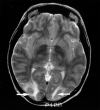Etiology of cortical and white matter lesions in cyclosporin-A and FK-506 neurotoxicity
- PMID: 11733324
- PMCID: PMC7973826
Etiology of cortical and white matter lesions in cyclosporin-A and FK-506 neurotoxicity
Abstract
Background and purpose: The etiology of the neurotoxicity associated with cyclosporin-A (CsA) and FK-506 treatment is not fully understood. At our institution, we noticed a distinct, abrupt change in the imaging characteristics of CsA and FK-506 neurotoxicity, which consisted of a shift in lesion morphology from a white matter abnormality to a mixed cortical and white matter pattern. The purpose of this study was to assess clinical parameters that might explain this change.
Methods: Twenty-two patients had a neurotoxic reaction and brain imaging changes while receiving CsA or FK-506. Nineteen patients received allogeneic bone marrow transplants, and three had aplastic marrow disorders. Fifty-one imaging studies (CT or MR imaging) were obtained, and lesion characteristics, locations, and time courses were evaluated along with relevant clinical data.
Results: Nine patients who had been conditioned for transplantation with cyclophosphamide and chemotherapy (busulfan or thiotepa) had a mixed pattern of cortical and white matter involvement (57 lesions). Isolated white matter involvement (62 lesions) developed in three nontransplant patients and 10 transplant patients conditioned with cyclophosphamide and total-body irradiation. All lesions occurred at typical brain watershed zones. Lesion enhancement was noted in two patients conditioned with chemotherapy. Initial images demonstrated characteristic lesions in 15 patients (68%). Initial images were normal in four patients (18%) and nonspecific in three patients (14%).
Conclusion: Lesion location in CsA and FK-506 neurotoxicity may depend on the presence or type of conditioning used before bone marrow transplantation. Nontransplant patients or those conditioned with total-body irradiation develop white matter lesions, whereas those conditioned with chemotherapy develop mixed cortical and white matter lesions.
Figures





References
-
- Joss DV, Barrett AJ, Kendra JR, Lucas CF, Desai S. Hypertension and convulsions in children receiving cyclosporin A. Lancet 1982;1:906 - PubMed
-
- Boogaerts MA, Zachee P, Verwilghen RL. Cyclosporin, methylprednisolone, and convulsions. Lancet 1982;2:1216-1217 - PubMed
-
- Dieperink H, Moller J. Ketoconazole and cyclosporin. Lancet 1982;2:1217 - PubMed
-
- Durrant S, Chipping PM, Palmer S, Gordon-Smith EC. Cyclosporin A, methylprednisolone, and convulsions. Lancet 1982;2:829-830 - PubMed
-
- Noll RB, Kulkarni R. Complex visual hallucinations and cyclosporine. Arch Neurol 1984;41:329-330 - PubMed
MeSH terms
Substances
LinkOut - more resources
Full Text Sources
